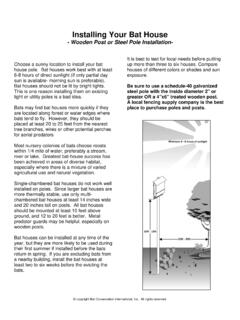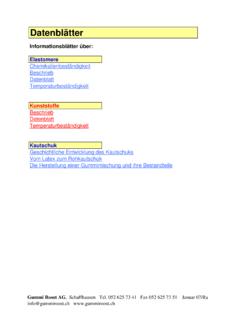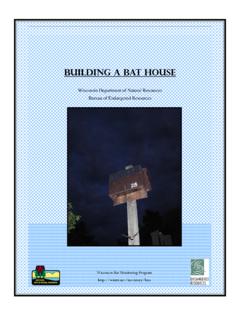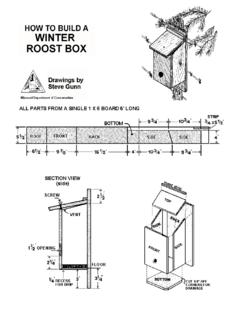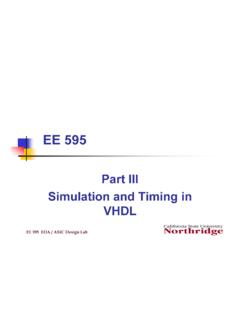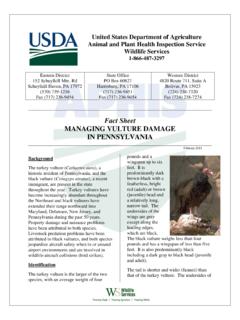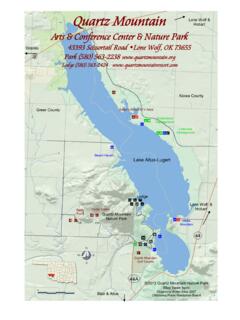Transcription of Criteria for Successful Bat Houses
1 Criteria for Successful Bat Houses Whether you build or buy a bat house , make sure the dimensions meet the Criteria below. Following these construction and installation guidelines will greatly increase your odds of attracting bats. These recommendations are based on 12 years of bat- house research conducted across the , Canada and the Caribbean. Small, poorly made Houses commonly sold in stores or any house improperly installed are likely to fail. Much more information is available on BCI s website: 1. DESIGN: All bat Houses should be at least 2 feet tall, have chambers at least 20 inches tall and 14 inches wide, and have a landing area extending below the entrance at least 3 to 6 inches (some Houses feature recessed partitions that offer landing space inside). Taller and wider Houses are even better.
2 Rocket boxes should be at least 3 feet tall and have at least 12 inches of linear roost space. Most bat Houses have one to four roosting chambers the more the better. Roost partitions should be carefully spaced 3/4 to 1 inch apart. All partitions and landing areas should be roughened. Wood surfaces can be scratched or grooved horizontally, at roughly 1/4- to 1/2-inch intervals, or covered with durable, square plastic mesh (1/8- or 1/4-inch mesh). Where average July high temperatures are 85 F or more, include vents approximately 6 inches from the bot-tom of all Houses that are 24 to 32 inches tall. Front vents should be as long as a house is wide, side vents 6 inches tall by 1/2-inch wide. Houses 36 inches tall or more should have vents 10 to 12 inches from the bottom. 2. CONSTRUCTION: For wooden Houses , a combination of exterior plywood (ACX, BCX or T1-11 grade) and cedar is best.
3 Plywood for bat- house exteriors should be at least 1/2-inch thick with at least four plies. Do not use pressure-treated wood. Any screws, hardware or staples used must be exterior grade (galvanized, coated, stainless, etc). To increase longevity, use screws rather than nails. Caulk all seams, especially around the roof. Alternative materials, such as plastic or fiber-cement board, may last longer and require less maintenance. 3. WOOD TREATMENT: For the exterior, apply three coats of exterior grade, water-based paint or stain. Observations suggest that color should be black where average high temperatures in July are less than 85 F, dark colors (such as dark brown or dark gray) where they are 85 to 95 F, medium colors where they are 95 to 100 F and white or light colors where they exceed 100 F.
4 Much depends upon amount of sun exposure; adjust to darker colors for less sun. For the interior, use two coats dark, exterior grade, water-based stain. Apply stain after creating scratches or grooves or prior to stapling plastic mesh. Paint fills grooves, making them unusable. Bat house color recommendations and average daily high temperatures in July 2 Areas Wooden Houses Plastic/Stucco Houses 1) Dark areas: black dark color 2) Medium: dark or medium color medium color 3) Light: medium color light color 4) Lightest: white or light color light color 4. SUN EXPOSURE: Houses where high temperatures in July average 80 F or less, should receive at least 10 hours of sun, and more is better. At least six hours of direct daily sun is recommended for all bat Houses where July s daily highs average less than 100 F.
5 Full, all-day sun is often Successful in all but the hottest climates. To create favorable conditions for maternity colonies in summer, internal bat- house temperatures should stay between 80 F and 100 F as long as possible. 5. HABITAT: Most nursery colonies of bats choose roosts within 1/4 mile of water, preferably a stream, river or lake. Greatest bat- house success has been achieved in areas of diverse habitat, especially where there is a mixture of varied agricultural use and natural vegetation. Bat Houses are most likely to succeed in regions where bats are already attempting to live in buildings. 6. MOUNTING: Bat Houses should be mounted on buildings or poles. Houses mounted on trees or metal siding are seldom used. Wood, brick or stone buildings with proper solar exposure are excellent choices, and Houses mounted under eaves are often Successful .
6 Single-chamber Houses work best when mounted on buildings. Mounting two bat Houses back-to-back on poles (with one facing north and the other south) is ideal. Place Houses 3/4-inch apart and cover both with a galvanized metal roof to protect the center roosting space from rain. All bat Houses should be mounted at least 12 feet above ground, and 15 to 20 feet is better. Bat Houses should not be lit by bright lights. 7. PROTECTION FROM PREDATORS: Houses mounted on the sides of buildings or on metal poles provide the best protection from predators. Metal predator guards may be helpful, especially on wooden poles. Bats may find bat Houses more quickly if they are located along forest or water edges where bats tend to fly. However, they should be placed at least 20 to 25 feet from the nearest tree branches, wires or other potential perches for aerial predators.
7 8. AVOIDING UNINVITED GUESTS: Wasps can be a problem before bats fully occupy a house . Use of 3/4-inch roosting spaces reduces the risk of wasps. If nests accumulate, they should be removed in late winter or early spring before either wasps or bats return. Open-bottom Houses greatly reduce problems with birds, mice, squirrels or parasites, and guano does not accumulate inside. 9. TIMING: Bat Houses can be installed at any time of the year, but they are more likely to be used during their first summer if installed before the bats return in spring. When using bat Houses in conjunction with excluding bats from a building, install the bat Houses at least two to six weeks before the actual eviction, if possible. 10. IMPORTANCE OF LOCAL EXPERIMENTATION: It is best to test for local needs before putting up more than three to six Houses .
8 Compare Houses of different colors or shades and sun exposure. copyright Bat Conservation International, Inc. All rights reserved. 1A3





